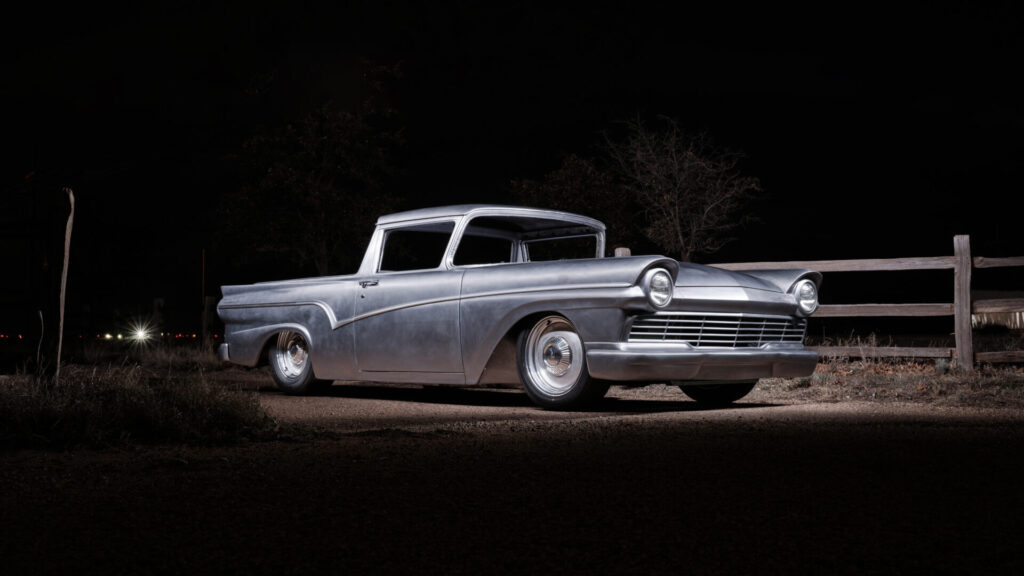
With many iconic classic cars, their final output was the result of what automakers and designers had at their disposal and based on standards of the era, there seems to always be room for improvement. Taking what we know now and with our refined eye, improvements now seem imperative. Improving the drivability, design, and the fit and finish are the major three that are typically focused on. This Ranchero is a great example of a vehicle built as if it was a redesign from a custom coach builder of 1957 but with the resources of today.
Classic cars often leave room for improvement, limited by the technology and design constraints of their time. With modern engineering and craftsmanship, these vehicles can be transformed into what they were always meant to be. This Ranchero is a prime example of reimagining a vintage icon with the resources of today—enhancing its drivability, refining its design, and elevating its overall fit and finish. From a reworked chassis and suspension to subtle body modifications and precision-crafted details, this build brings a fresh perspective to a timeless classic.
With many iconic classic cars, their final output was the result of what automakers and designers had at their disposal and based on standards of the era, there seems to always be room for improvement. Taking what we know now and with our refined eye, improvements now seem imperative. Improving the drivability, design, and the fit and finish are the major three that are typically focused on. This Ranchero is a great example of a vehicle built as if it was a redesign from a custom coach builder of 1957 but with the resources of today.
Starting with the foundation, the original chassis was heavily reworked with a new IFS front clip and a 9” rear axle located by a parallel four-bar/panhard rod. A new rectangular steel X-crossmember was fabricated to add additional rigidity to the frame. The suspension was engineered for the car/truck to be driven low to the ground without needing air bag suspension to maneuver over road obstacles. A custom stainless steel exhaust routes through the new crossmembers and out the rear of the vehicle.
The body itself was wedge-sectioned 1 ½” towards the front of the car. This was a kill-two-birds-with-one-stone scenario that helped lower the front sheet metal down, allowing the bumper to get closer to the ground where it naturally needed to be. The original bumper location looked awfully peculiar being so high in the front of the vehicle, and being able to see the front suspension is rarely a good look on a street-only vehicle. By slightly lowering the front of the vehicle’s body, it gave the car a subtle but more aggressive look. In fact, so subtle that it would probably go unnoticed unless parked next to an original stock Ranchero.
Being that the sectioning was taken out of the bottom of the car instead of the middle, the doors themselves were the only thing that really needed additional modifications during the rust repair phase. Following suit, new rocker panels were fabricated slightly taller to hide more of the frame rail when viewing the car from the side, and the pinch weld was relocated to the inside, cleaning up the look of the bottom of the car even more compared to factory.
A new firewall was in order to help move the updated Ford fuel-injected power plant back, allowing for the oil pan to clear the front crossmember. While we were at it, a new floor and transmission tunnel was fabricated to fit the updated transmission for the drivetrain, which now sits slightly higher in the frame because the vehicle is so low to the ground. With the new ride stance, the rear wheel openings were raised up 2 ½” so more wheel and tire were visible. The bead detail reveal over the rear wheel was also angled back slightly for a more aggressive look. New inner and outer wheel tubs were also fabricated. A new bed floor from a late model truck was modified and placed 1” higher to clear the coil-over shocks, preserving the smooth ride.
Moving on to the rear of the car, you’ll see that the tailgate was heavily reworked and now has an excellent fit and finish. The factory bed trim was less than desirable, so it was tackled next. Our customer wanted to have as few trim seams as possible while removing all the exposed screw heads. It was refit, spliced, and refit again, welding each section to the next. New corners were seamlessly fabricated from flat stainless steel and then grafted into the original back window trim.
Small stainless steel plates with studs were welded to the back side of the trim. Once the trim was completed, multiple body modifications were made to allow the trim to be bolted down from the back side of each area around the bed opening. Almost all of the rear bumper was abandoned except the center section. The rest of the bumper was made from scratch, especially the corners that were molded to the shape of the body. This allowed the fitment to be pulled up tighter against the body. New custom CNC-machined taillight housings were made and grafted into the body to remove the ill-fitting original pot metal pieces. The seam removal makes for a much cleaner, smoother look.